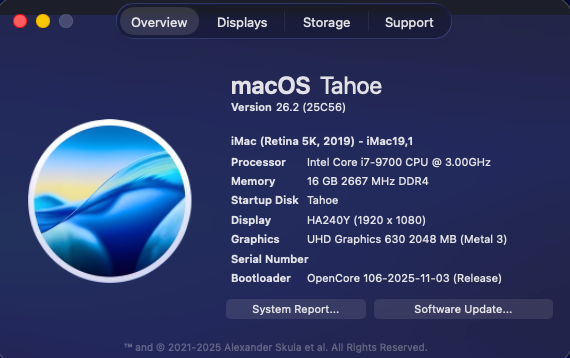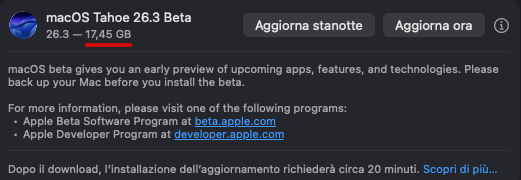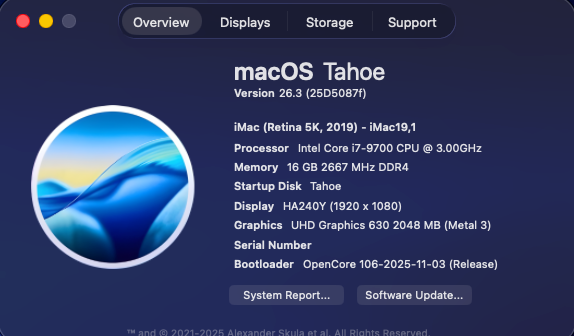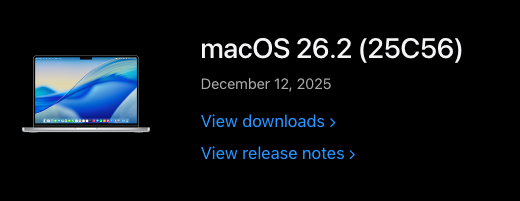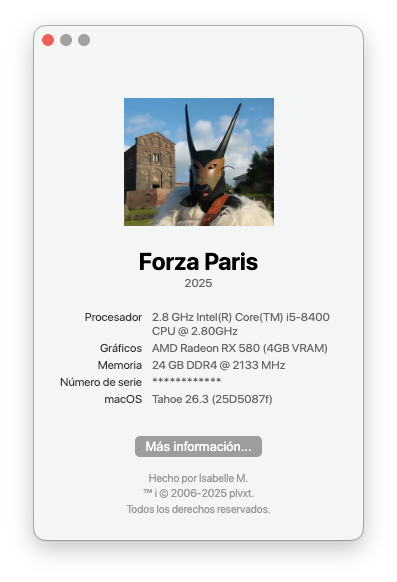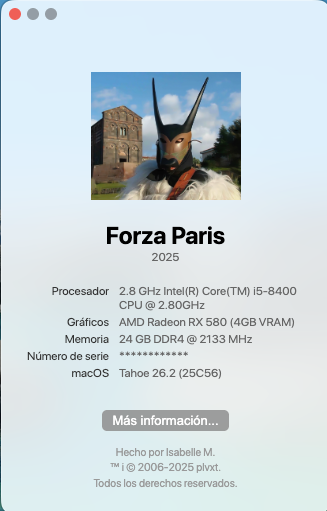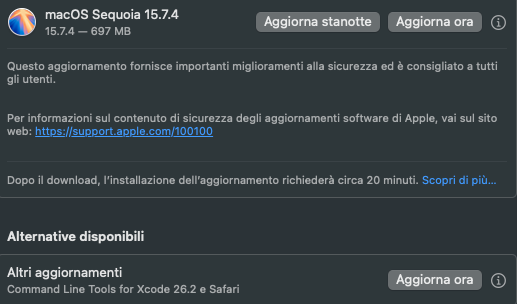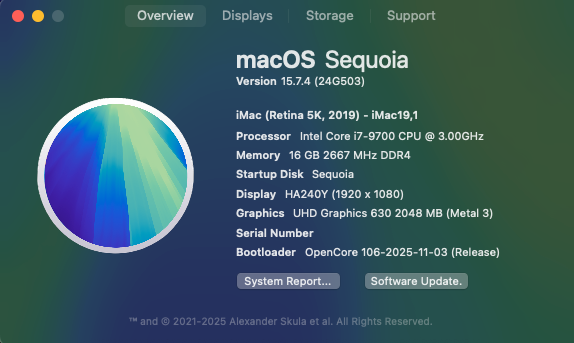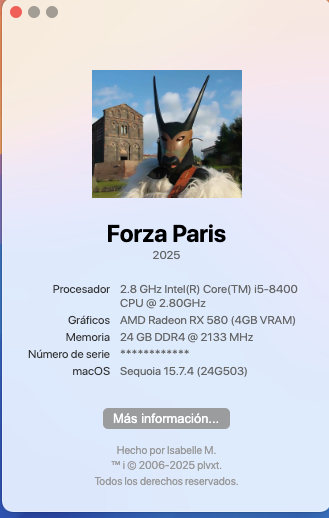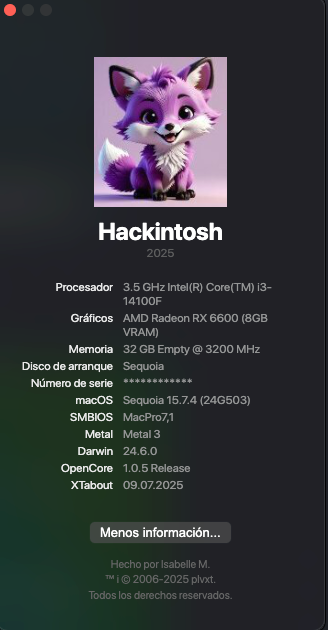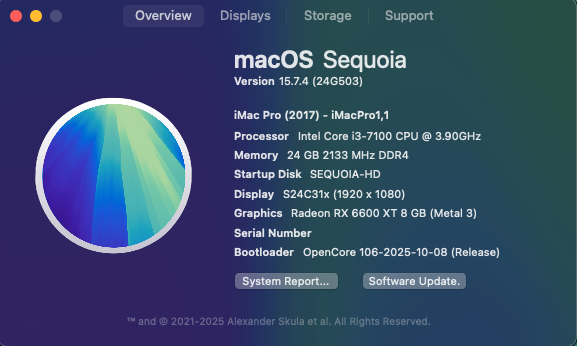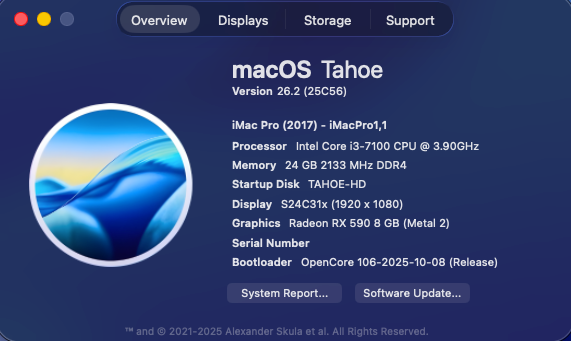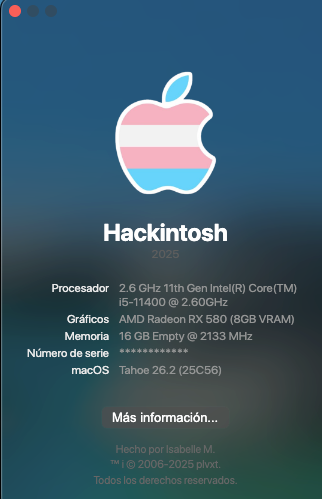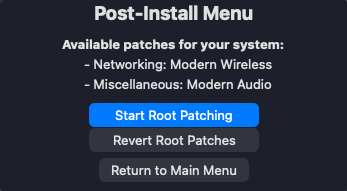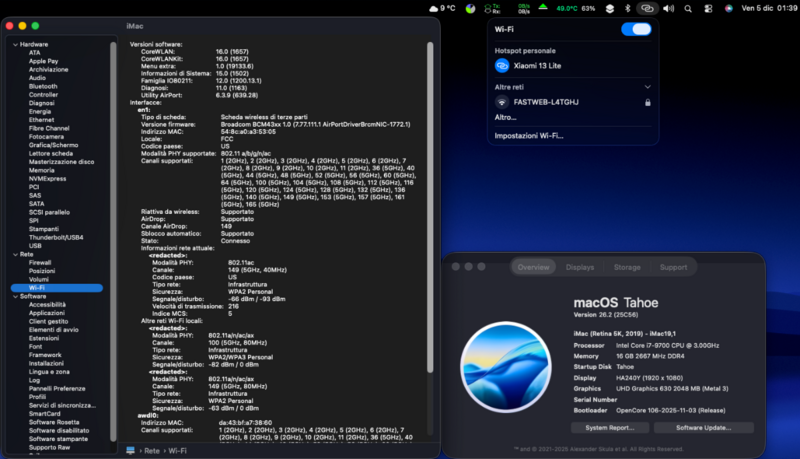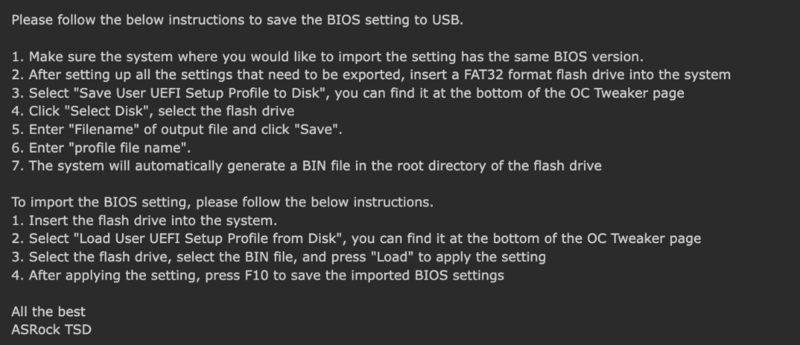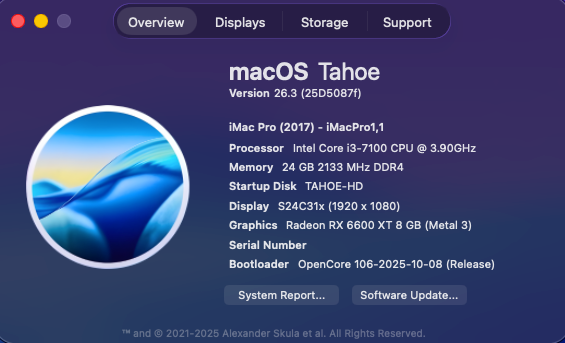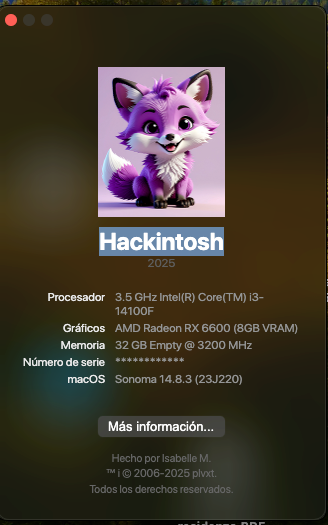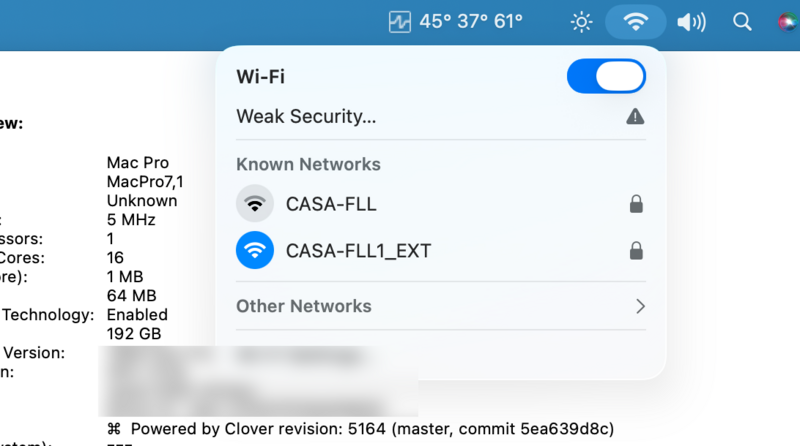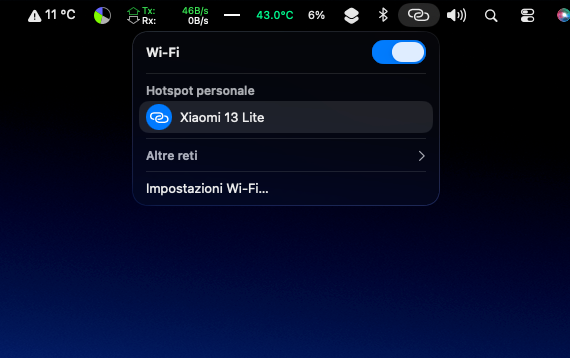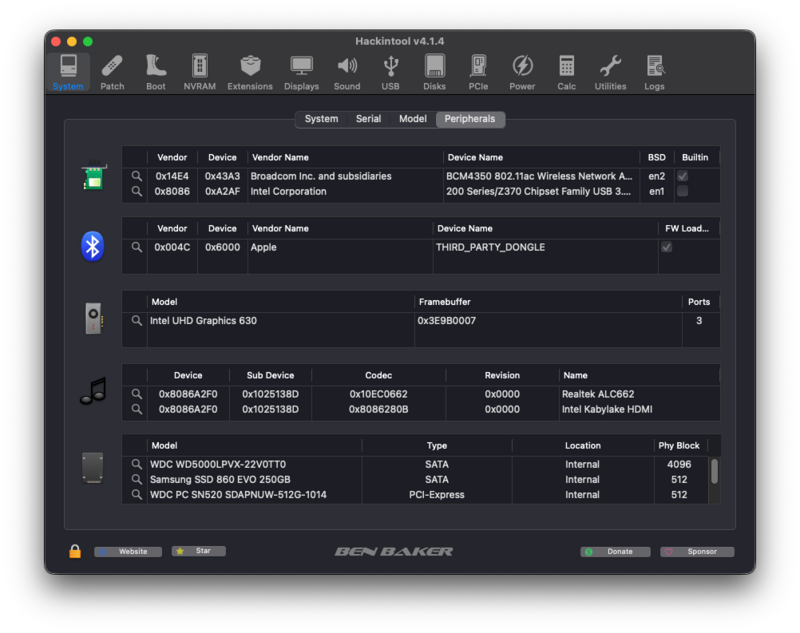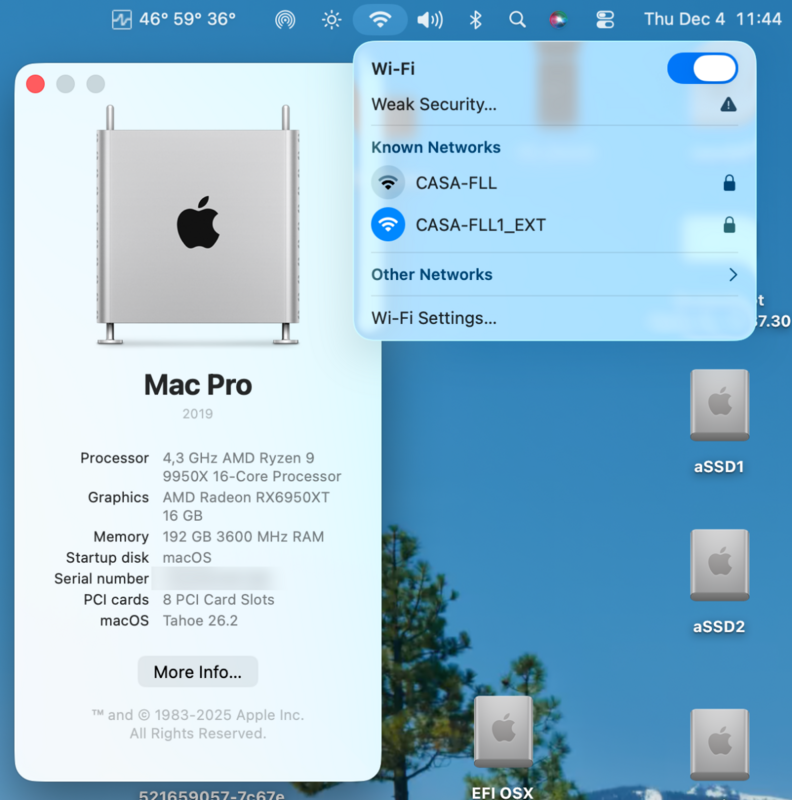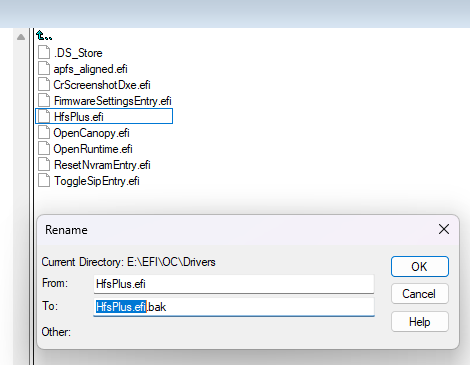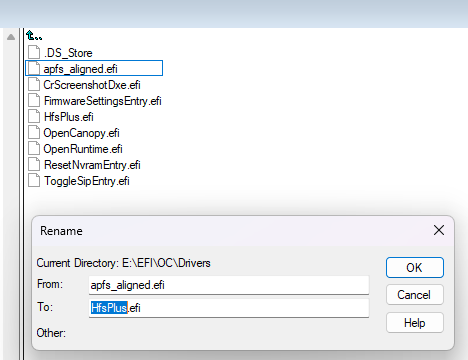Leaderboard
Popular Content
Showing content with the highest reputation since 11/25/2025 in all areas
-
Auguri raga, un altro anno è passato, stesse rogne di sempre 🙂 , speriamo in un cambio di passo nel 2026... Guarda chi si rivede il mio amico @Gengik84 😁5 points
-
5 points
-
5 points
-
5 points
-
4 points
-
4 points
-
4 points
-
4 points
-
4 points
-
4 points
-
4 points
-
4 points
-
4 points
-
4 points
-
4 points
-
Con Amfipass.kext non va Serve il boot-args ancora ( amfi=0x80 ) Edit: Rimosso amfi=0x80 abilitato amfipass.kext Aggiunto -amfipassbeta in boot-args ( alternativa se non va -lilubetaall ) Partito ... 😛 wortks ! Si ritorna a parlare il mandarino 😀 Install Driver Patches Installable Patches: - Network Card: BCM Wireless Network Card - Miscellaneous: Audio Patches ! Per chi puo' farne a meno di AppleHda / Alc , puo' desezionarlo dall impostazioni dell app !3 points
-
3 points
-
3 points
-
3 points
-
Tanti auguri a tutti/e di Buon Natale e felice anno nuovo 2026.💫🥂 Vi seguo sempre anche se ho dismesso da svariati mesi il mio hackintosh e sono passato ad Apple con Mac Mini. Saluti!🤩3 points
-
3 points
-
3 points
-
Tahoe 26.3 Beta 1 (25D5087f) Full Installer https://swcdn.apple.com/content/downloads/08/08/089-61660-A_BDNQD10OAE/dxyekmr1r0ragzx9rhh12naryoq3jkb6q7/InstallAssistant.pkg3 points
-
3 points
-
3 points
-
3 points
-
In attesa che AmfiPass.kext venga aggiornato / firmato e' consigliato per chi ha problemi con le app tipo Firefox , usare il boot-args : ipc_control_port_options=0 " E' un argomento d avvio di macOS utilizzato come soluzione alternativa, in particolare nelle configurazioni Hackintosh o quando si disabilita la protezione dell'integrità del sistema (SIP),per impedire che app specifiche (come le app Electron, Skype, Spotify, Discord, WhatsApp...) si arrestino in modo anomalo a causa di conflitti di sicurezza a livello di kernel, che influiscono in particolare sulla grafica e sulla gestione degli input In sostanza, dice al kernel di allentare alcuni controlli di comunicazione, consentendo alle applicazioni modificate o con patch di funzionare senza errori, ma riduce la sicurezza del sistema. "3 points
-
Ci scusiamo per il linguaggio. (Google translate 🙂 ) Il kernel/patch AMD non è corretto. Non è possibile utilizzare SMBios desktop su un laptop. Perché VirtualSmc.kext è disabilitato? I kext Wi-Fi/BT devono essere disabilitati durante l'installazione. Riceverai un errore durante l'installazione con NootEdRed.kext. Installa con WEG.kext. Quindi sostituisci questi due kext. Prova con l'EFI allegato. Non dimenticare di reimpostare la NVRam. https://drive.google.com/file/d/1T-LDaJrDLYfakyBulgN7Cualwm6lpqZl/view?usp=sharing3 points
-
3 points
-
3 points
-
3 points
-
Nuovo Kernel Debug Kit 26.2 build 25C56 https://developer.apple.com/download/all/ GitHub https://github.com/dortania/KdkSupportPkg/releases3 points
-
Chi prova 😝 ? Sembra si stia muovendo qualcosa per far andare il WI-FI anche su Tahoe grazie al Fork del Dev lzhoang2801 e EduCovas per le patch 🙏THX " New modern wireless patchset for macOS Sequoia and Tahoe New metal_31001 GPU patchset for macOS 13.0+ " https://github.com/lzhoang2801/OpenCore-Legacy-Patcher/releases/tag/3.0.0 Link diretto : https://nightly.link/lzhoang2801/OpenCore-Legacy-Patcher/workflows/build-app-wxpython/tahoe-patchset?preview ( OpenCore-Patcher.pkg ) Rimuovere eventuali installazioni di OCLP / MOD precedenti La configurazione rimane quasi invariata come da guida qui al primo post Rimuovere il MaxKernel ( 24.99.99 ) s e' impostato nei Kexts e nel Block , lasciare solo il MinKernel ( 23.0.0 ) Con AmfiPass.kext va in blocco , ( probabilmente ha bisogno di essere aggiornato o approvazione " firma Dortania " ) si può anche disabilitare Usare invece il boot-args amfi=0x80 Abilitato VT-D nel Bios + DisableIoMapper in Kernel - > Quirks , Funziona ( * nel mio caso * ) Rilevate le Patch disponibili per il WI-FI e AppleHda Completato il patching con successo report-oclp.zip Ma al riavvio si blocca ( la mia scheda non e' una BMC4360 bensi una BMC4350 😔 ) Success !!! ! Non e' OCLP ufficiale ( potrebbe diventarlo se fuziona e viene accolto dai Dev s di OCLP ufficiale ) ! Usare con cautela ! Anzi uso direttamente la nota dello Sviluppatore : " Questo è un fork sperimentale pensato per testare le prime patch per la prossima versione di OpenCore Legacy Patcher 3.0.0 . Questo fork è stato creato per uso personale e non mi assumo alcuna responsabilità per eventuali problemi che altri potrebbero riscontrare durante l'utilizzo. " In caso di blocco al riavvio ( Si spera di no 🤞 ) e' possibile ripristinare da Recovery , tramite Shell da Terminale : mount -uw /Volumes/Tahoe bless --mount /Volumes/Tahoe --bootefi --last-sealed-snapshot ( Sostituire Tahoe con il nome che avete assegnato al Disco ) Qundi se non riuscite poi in caso di blocco a riprenderlo da Recovery o almenoche' non avete un immaggine di Sistema completa ! non provate ... aspettate il rilascio ufficiale ! * * * * * * * * * * * * * * * * * * * * * * * * * * * * * * * * * * * * * * * * * * * * * * * * * * * * * * * * * * * * * * * * * * * * * * * * * * * * * * * * * * ( Abilitazione del WiFi nativo con AirportItlwm ( senza Heliport.app ) ! Solo per le schede wireless Intel ! Va aggiunto AirportItlwm.kext per Ventura , con rispettivo Spoof verso BMC4360 https://github.com/randomappleboi/Native-Wifi-for-Hackintoshes-with-Intel-Wireless-cards-on-macOS-sequoia ) Buona Fortuna 🙂3 points
-
https://github.com/laobamac/OCLP-Mod dovrebbe funzionare con amfipass.kext2 points
-
2 points
-
ciao dany il ryzen necessita di aggiornamenti nella sezione Kernel/patches per le patches relative alle CPU amd, di solito utilizzando le ultime che trovi sul github di AMD Kernel patches hai anche la retro compatibilità con OSX piu' vecchi rispondo anche qui riguardo le patches per wifi ricordo a te ma anche a Giaccaz che se si utilizzano i blocchi con min kernel e max kernel si puo' decidere dove far applicare o meno un kext o un blocco Se hai maxkernel inpostato su 24.99.99 il kext o i kexts non verrà /verranno applicati su tahoe Da qui spesso si genera confusione quando tutto funziona come deve non c'e' bisogno di fare altro nel config.plist Solo il revert delle patches via OCLP se si vuole installare tramite aggiornamento (delta update), o non fare revert e scaricare circa 17 Gb come ci propone il pc quando aggiorniamo senza revert Il problema AMFI come il SIP tra l'altro non dovrebbe essere relativo a quale scheda grafica sia montata nel pc, sempre la EFI /config.plist fa riferimento a questo Per la scheda grafica invece e' condizionante l'ultilizzo o meno di whatevergreen (che se serve e non e' patchato non porta a compimento i primi riavvii in modo regolare) Sempre su Tahoe, altro problema che si riscontra nell'aggiornare da un sistema vecchio come sequoia o inferiore e' la faccenda delle USB che vanno per forza adattate per farle andare su TAhoe Ps ho risposto a te ma non e' solo per te questa spiegazione non richiesta 🙂2 points
-
si se ne parla molto nel forum poi dopo la decriptazione puoi' rimettere come ti funzionava Su hack si riesce a far andare tutto sulla macchina che hai in firma devi aspettare che raggiungano donazioni sufficienti per rilasciare OCLP aggiornato per tahoe Il problema "password" e' comunque indipendente..sia dalle donazioni che da OCLP! 😉2 points
-
2 points
-
2 points
-
lzhoang2801 ha rilasciato un nuovo Commit Pare che quello iniziale cercava di applicare le Patch , oltre ad AppleHda e W-Fi , anche a DGPU tipo Kepler ... non ancora ufficalmente supportate Messo su , dopo aver fatto prima il Revert Root Patches e disintallato quello precedente con l apposito PKG " OpenCore-Patcher-Uninstaller.pkg " ... funziona come il primo senza intoppi2 points
-
ma figurati....niente scuse in fondo siamo qui per questo per darci consigli reciprocamente.2 points
-
Se utilizzi il kext amfipass.kext questo non funziona bene su Tahoe e le patches che stanno uscendo per il wifi/audio si usa il bootarg amfi=0x80 che da problemi per alcune applicazioni come firefox e dropbox al momento non ci sono soluzioni pubbliche2 points
-
2 points
-
Ragazzi mi sono avventurato pure io ed sembra essere andato tutto bene. grazie ad@Anto65 per la spiegazione 🙂 Vedremo come andrà il sistema.2 points
-
2 points
-
@danysii pronto ad avere un piano B 🙂 E' un fork sperimentale come dice bene Anto e magari qualche problema c'e' io dopo aver fatto un po' di errori al momento lo uso con molta soddisfazione ma trattare con cura 🙂2 points
-
2 points
-
2 points
-
2 points
-
2 points








